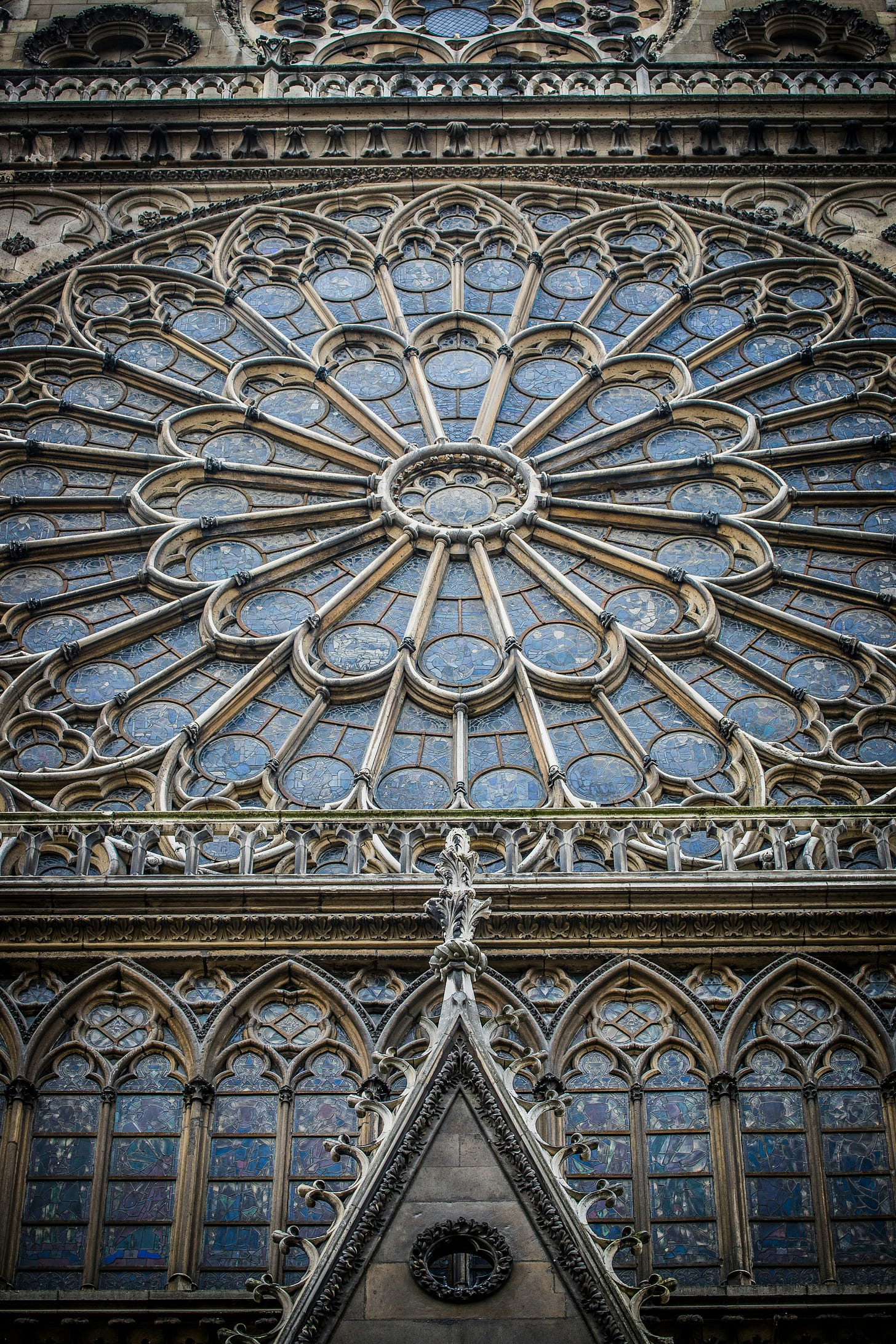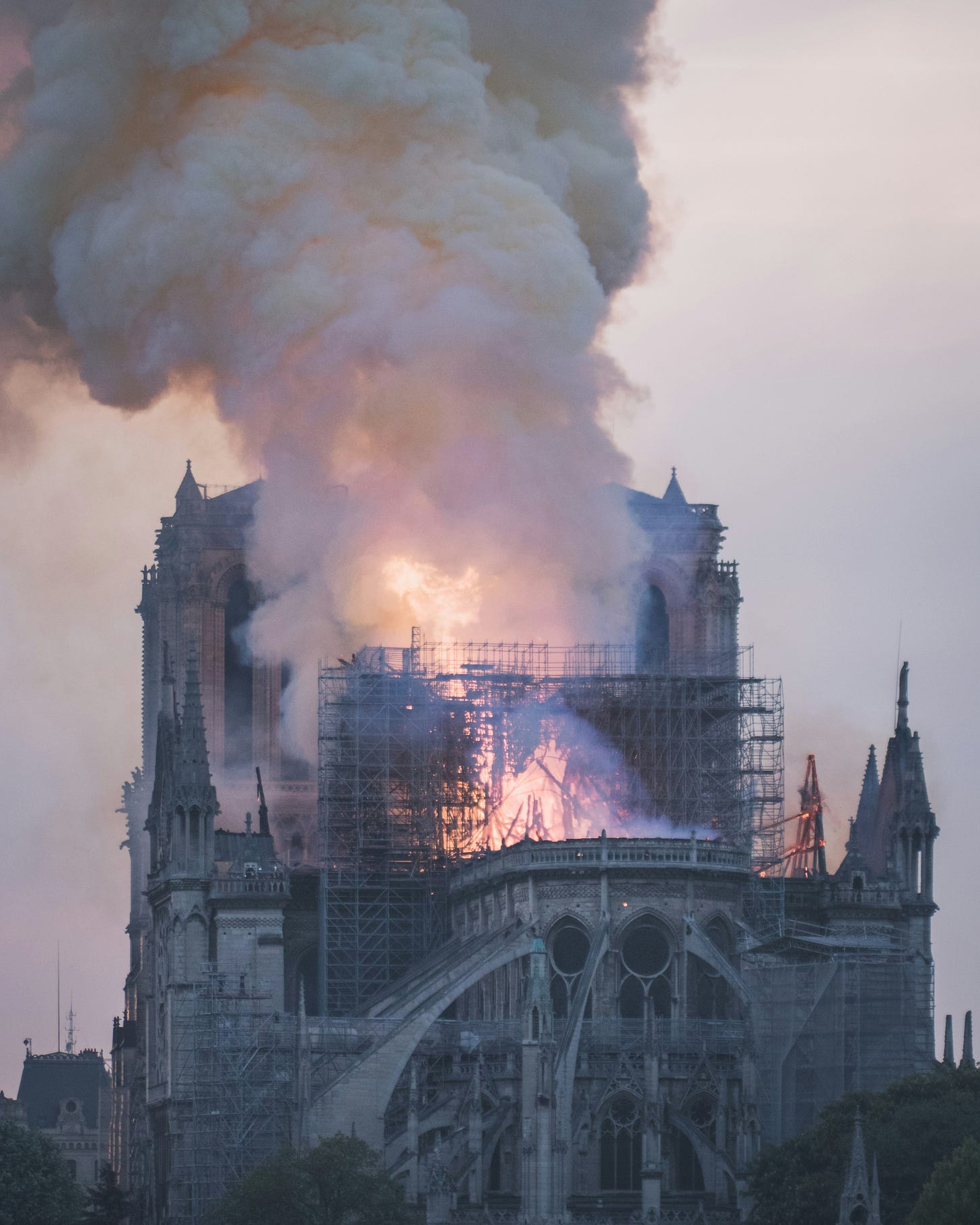Photo by Stephanie LeBlanc via Unsplash
“He does not
collect from us one-tenth
but all.” — Madeleine L’Engle, “A Cry Like a Bell”
I recently had the opportunity to experience a stunning digital art exhibit at the The Museum of Fine Arts, Houston honoring the rebuilding of Notre-Dame Cathedral in Paris, France. I remember watching the news in horror as smoke plumed in gracefully building columns above the gothic marvel on April 15, 2019. It felt like a violation, a tragic loss that left me with a lingering sense of strange grief for several days. When the smoke cleared and the wreckage had been evaluated, the long and painstaking project of renewal began…and culminated in the reopening of the beloved landmark this past December.
As I settled into the large room at the museum, tall screens towering over me on three sides depicting the interior and exterior wonders of Notre-Dame in tiny laser points, I was struck with the reality that the efforts of over 2,000 individuals garnered with the knowledge and wealth of our modern age, afforded the support and collaboration of governments, communities, artisans, and patrons had restored only a portion of this gigantic masterpiece. The work they accomplished over five years is astounding and a testimony to the enduring legacy and impact of such structures. But as the laser point depictions surrounding me mounded into swelling scenes of Notre-Dame’s intricacies, grandeur, and history, I wondered at the dedication and testimonies of those whose entire lives were given to its inception and original work…those whose imaginations, faith, steadfastness, and generosity built such a wonder in the first place.
Why did men and women build cathedrals at all?
Inspired by the exhibit, I’ve returned to one of the great gifts of historic fiction, “The Pillars of the Earth” by Ken Follett. A rather large tome (and only the second in the five-book series), it is an epic spanning the lives of those responsible for the building of a cathedral in Great Britain. It’s length feels necessary. In an age where we grow impatient with homebuilders after a period of only six months, the idea of giving one’s entire life, livelihood, and creativity to a singular project—one which you know you will never witness the completion of—seems ridiculous. And yet we observe in the innumerable details and all-encompassing grandeur of cathedrals such as Notre-Dame the deep reverence, the passionate imaginations, and holy inspiration that must have filled those responsible.
“He wondered if he really was capable of it. Then he thought what a thrill it would be to create something from nothing; to see, one day in the future, a new church here where now there was nothing but rubble, and to say: I made this.”—Ken Follett, The Pillars of the Earth
Nobles, clergymen and women, artisans, builders, kings, laypeople, and children all bent their backs, exercised their God-given talents, and opened their purses and faith to not only the idea of such a task as building a cathedral…but saw it through to completion. And such work wasn’t without great risk. Lives were lost, generations endured through before the fruit of their labor was made evident.
Even in 2019 and 2025, our horror at the harm of such beauty as Notre-Dame and our fervor in its healing makes us realize that the story of these cathedrals continues on. Our hearts are still inspired by these aging stones.
Photo by Nivenn Lanos via Unsplash
There is so much that could be said and explored through the history and lives of these great buildings, but the thought that continues to resound in my mind is the question, “What is the cathedral stone of my own life?” What are we building? What are we entrusting to God with such brazen faith in our own communities, through our own resources, with our giftings and imaginations?
Have we settled so low that we cannot even dream of such beauty being realized as that of a cathedral?
Have we traded the holiness of recreation for the convenience of minimalism?
Dale Ahlquist, in a podcast interview on Trinity Forum Conversations, states that “our loss of imagination is a sign of decadence.” What has our reliance upon postmodernism gifted us with? Apathetic passivity. If there is no Creator, if we ourselves are not masterpieces designed by Love Himself, then we can be satisfied with the simplicity of a straight line and the cheapness of brittle material. Our lives have no meaning…so why should our dwelling places? Much less should we even consider the necessity of a place of worship or the exploration of our God-inspired imaginations.
“They stopped being able to be amused. They stopped being able to be thrilled and be entertained and they had to start, as Chesterton says, ‘stabbing their eyes’…in order to have any sensation. When a civilization becomes deadened, it starts falling apart…And the only way that it can be rejuvenated is through the Creator himself, who can re-create, which is what ‘recreation’ is supposed to be, is ‘re-creation.’ And it’s an act of discipline to exercise our imagination.” — Dale Ahlquist, Trinity Forum Conversations Podcast, Ep. “The Strangest Story in the World: G.K. Chesterton & the Incarnation”
Have we lost the discipline of imagination?
Today, the idea of recreation brings to mind experiences out-of-doors, lists of projects to complete, even perhaps a sense of self-entitlement. Recreation seems a luxury that we are supposed to set aside time for but never do. We deserve it, somehow, but we rarely commit to its call.
We certainly don’t view recreation as a holy calling, an invitation to join our Creator in creating that which is good and beautiful and glorifying of our Savior’s work in the earth, in our hearts, and throughout the timeline of eternity.
Why did men and women build cathedrals?
It’s not because God needed a place to live. They were not assuming as such. Surely, there were human motivations—there always are—of pride, vanity, and selfish ambition…but there must have also been the belief that what they were creating mattered. Most of those who started the foundational work of these cathedrals knew they wouldn’t see it stand complete and radiant in its final hour. But they knew that their lives were part of a story…an eternal reality that promises to thread each of our lives and the works of our hands and the meditations of our hearts into the glory of an eternal tapestry woven together by God, the First & Last Creator.
Are not we ourselves, christians dwelling earth-bound, imbued with the same knowledge, the same faith as these builders of cathedrals? And so, I ask again, what cathedral stones are we tending to, polishing, and carving today? Or are we limiting the resources of our creativity, our woodlands, mountains, riverbeds, and gardens?
“Having faith in God did not mean sitting back and doing nothing. It meant believing you would find success if you did your best honestly and energetically.” — Ken Follett, “The Pillars of the Earth”
If God inspired and enabled the citizens of the medieval world with all its sundry limitations to articulate into physical being the brilliance of stained glass windows, carved columns of stone mounting into dizzying heights, and the gracefulness of sweeping arched buttresses—then imagine what we could accomplish with the gifts and opportunities of our modern age.
We are called to recreation. Recreation inspired by the Holy Spirit for the glory of His kingdom and for the shaping of our cultures. Cathedrals were not built by individuals. They were built by communities with cultures of sacrificial imagination.
“We cannot wait till the world is sane
to raise our songs with joyful voice,
for to share our grief, to touch our pain,
He came with Love: Rejoice! Rejoice!”
— Madeleine L’Engle, A Cry Like a Bell, “First Coming”
Let us gladly tend to and offer our cathedral stones and rejoice at the epic to which we belong—the epic of our Creator’s love. The work of our imaginations today matters for eternity.
Photo by Bethany Beck via Unsplash







This is so beautiful, Emily. You wrote right into my soul. Thank you.
Deb
Very thought provoking.